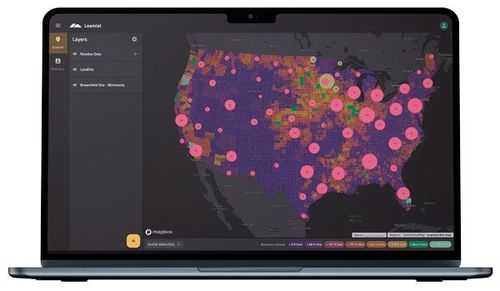Tackling the Biomass Challenge

The Loamist Biomass Explorer program uses a GIS platform that integrates over 50 data layers to provide instant feedstock analysis at any point location in the U.S. PHOTO: LOAMIST
June 6, 2024
BY Andy Miller and Pete Christensen
Despite its abundance, low cost and widespread utility, waste biomass is hard to access. Being able to locate, validate and transact feedstocks quickly and repeatedly is critical to scaling the bioeconomy. Addressing these challenges, Loamist developed a platform to simplify location, validation and transaction of waste biomass, ultimately reducing feedstock risk.
Background
With a combined 40 years of experience and background in circular economy research and traceable supply chains, the cofounders of Loamist decided to focus full time on accelerating the bioeconomy. Quickly, waste biomass was identified as the most expedient path to realizing a scalable, circular bioeconomy. Unlike liquid crude oil feedstocks, biomass is almost always in solid form with low density (i.e., wood chips, corn stalks, grasses, etc.), making it costly and inefficient to transport large distances. At least for now, biomass supply chains will remain local to the sources, so the hurdle is identifying the location of these best sources to locate near them. Loamist was formed to tackle this challenge head-on: How do we enable the bioeconomy by increasing access to local waste biomass resources?
Understanding Feedstock Risk
Feedstock risk is a significant hurdle for companies operating in the biofuel and bioenergy sectors. Biomass feedstock supply can be notoriously unpredictable; availability and consistency can fluctuate due to factors like seasonality, geographic distribution and competition from other uses. For bioeconomy projects, which rely on consistent feedstock supply, these variables can make or break the economic feasibility of new projects.
Advertisement
Advertisement
The intention behind the Loamist Biomass Explorer platform is to reduce feedstock risk by providing instant feedstock analyses for any location in the United States by considering over 50 data layers. These cover essential aspects such as feedstock availability, land attributes, local infrastructure and competitive demand for feedstocks, thus reducing the time and cost associated with choosing an ideal, low-risk site selection. This is done through integration of the following features.
Biomass Explorer Platform Features
GIS tool for strategic site selection: A purpose-built GIS platform was developed, which, as aforementioned, integrates over 50 data layers to provide instant feedstock analysis at any point location in the U.S. This tool allows project developers to evaluate potential sites for biomass projects quickly. Analysis tools allow users to do instant feedstock basket analysis around a specific point, as well as instant transportation distance and estimated cost analysis.
Connection with reliable suppliers: Beyond identifying where the biomass is, users can get it consistently by being connected through a network of verified suppliers. This network is crucial for maintaining a stable supply chain and mitigating risks associated with biomass sourcing. By building a robust network of prequalified suppliers, we ensure that clients have access to consistent and reliable biomass sources.
Advertisement
Advertisement
Compliance and certification tools: Loamist also tackles the regulatory landscape of the bioeconomy. A suite of tools helps users navigate the complexities of low carbon fuel standards and the U.S. Renewable Fuel Standard renewable identification numbers. Compliance is simplified by prequalifying biomass for these standards through the use of artificial intelligence to facilitate supplier verification with automated attestation forms. Loamist also partners with testing labs to manage test data results so users can measure feedstock variance over time and quickly qualify supply.
Track and trace system: Finally, Loamist offers a track and trace system that validates the supply chain, ensuring transparency and accountability. This system is essential not just for operational efficiency, but also for proving and improving carbon intensity scores, a critical measure for environmental impact in the bioeconomy.
Conclusion
In conclusion, Loamist believes its platform represents a significant leap forward in managing one of the most challenging aspects of bioenergy and biofuel production. As the bioeconomy continues to evolve, tools like the Biomass Explorer Platform will be crucial in ensuring its growth is sustainable and impactful. These technologies not only promise to streamline operations, but also to facilitate a more sustainable future, turning the potential of waste biomass into a cornerstone of a greener economy.
Authors: Andy Miller and Pete Christensen
www.loamist.com
andy@loamist.com
pete@loamist.com
Upcoming Events





